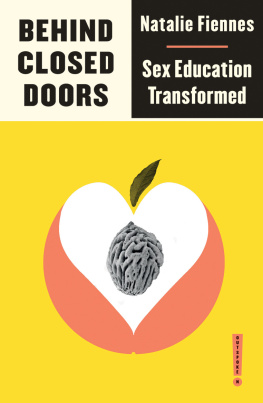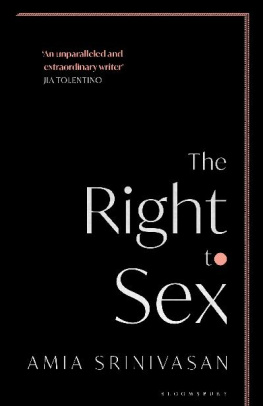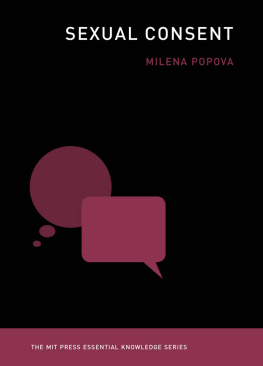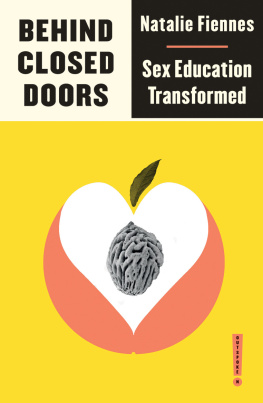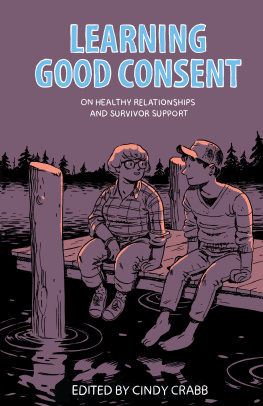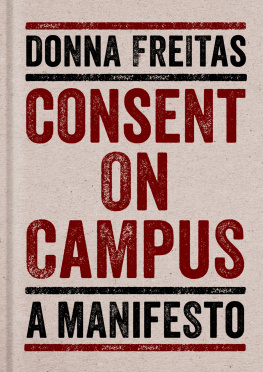Contents
Guide
Behind Closed Doors
Outspoken
Series Editor: Neda Tehrani
Platforming underrepresented voices; intervening in important political issues; revealing powerful histories and giving voice to our experiences; Outspoken is a series unlike any other. Unravelling debates on sex education, masculinity, feminism, mental health, and class and inequality, Outspoken has the answers to the questions youre asking. These are books that dissent.
Also available:
Mask Off
Masculinity Redefined
JJ Bola
Feminism, Interrupted
Disrupting Power
Lola Olufemi
Split
Class Divides Uncovered
Ben Tippet
Behind Closed Doors
Sex Education Transformed Natalie Fiennes
Natalie Fiennes

First published 2019 by Pluto Press
345 Archway Road, London N6 5AA
www.plutobooks.com
Copyright Natalie Fiennes 2019
The right of Natalie Fiennes to be identified as the author of this work has been asserted by her in accordance with the Copyright, Designs and Patents Act 1988.
British Library Cataloguing in Publication Data
A catalogue record for this book is available from the British Library
ISBN 978 0 7453 3873 6 Paperback
ISBN 978 1 7868 0499 0 PDF eBook
ISBN 978 1 7868 0501 0 Kindle eBook
ISBN 978 1 7868 0500 3 EPUB eBook
This book is printed on paper suitable for recycling and made from fully managed and sustained forest sources. Logging, pulping and manufacturing processes are expected to conform to the environmental standards of the country of origin.
Typeset by Stanford DTP Services, Northampton, England
Simultaneously printed in the United Kingdom and United States of America
Contents
Acknowledgements
To all the extraordinary young people I spoke to writing this book: your inspiration kept me going. To my friends and my editor: Neda, the Fiennes family, Ben, Lydia, Laetitia, Otti, Hannah, Sam, Harriet, Emma, Joanna, Naomi, Vida, Lily and Elly. And to the many more who held my hand along the way.
Introduction
She may be a bag of trouble: A short history of sex education
I had my first sex education class when I was eleven. We piled into the classroom and sat down in rows facing a tiny blank screen. We were mostly naive and almost entirely bored. When the teacher came in she explained that we were about to watch a video of a woman giving birth. She reassured us that yes, we might feel a bit queasy, but not to worry because it was all very natural and normal and besides, this is how we all came into the world. She pressed play. Within seconds one of the boys fainted. He slid off his stool and crumpled, whimpering, into a mound of oversized blazer on the floor. It was terrifying the perfect contraceptive.
The next (and final) instalment took place when I was 13. In this session, the schools agonised vicar muttered under his breath about teen pregnancies, the horrors of AIDS and the very precise symptoms of gonorrhoea. After an initial preamble, he opened up the ominous black briefcase he had brought along with him. Lo and behold, it contained behind a very thick pane of glass an intriguing selection of small plastic bags, white powders, pill packets and green herbs. He awkwardly gestured towards the morning after pill, a bag of cocaine, a diaphragm and a bag of weed. The briefcase was slammed shut and we were dismissed.
As I would discover researching for this book, most young people in the UK might have some semblance of a sex education at school, but school was not where they learned about sex. Some might have been taught by religious leaders or family members, but the overwhelming majority were left to fend for themselves, asking sly questions to friends and older siblings, learning by mistake, looking this-and-that up online, and always, always finding an excuse to scuttle away when the topic was breached by parents. Despite the torments, I presumed that things were better than they had been in the past. Surely the awkwardness of my schools vicar was preferable to those vicars of the past railing about sin, blindness and the fiery pits of eternal damnation.
Sex education has changed wildly throughout time and continues to vary around the world today. This should come as no surprise. The way that sex education comes to be taught or indeed not taught depends on some pretty central questions. Take the very idea of a young person. What does it mean to be young? Is it to be innocent? Irrational? Reckless? And what even is the role of education? Is it something that should be left to parents? Maybe its corrupting to teach children about adult things. And what about sex? What is normal sex? Or good sex? Is it for procreation? For spiritual and religious ends? But what about non-heterosexual sex? And what about gender? Or marriage?
An American school board member wrote in 1986, Theres an old saying that there are only two things for certain in this world; death and taxes, a third certainly might be added: disagreement about sex education. Sex is extremely personal, arguably the highest form of intimacy of all, but it is also connected to a complicated web of forces outside of the self. From culture, religion, class, race, gender, all the way to the randomness of which constituency you grow up in and how much funding your school receives, sex is political.
The seeds of sex ed
Formal sex education as we know it now might not have been around for long, but sex education has always existed. Before printing presses and even before classrooms were introduced, knowledge was transferred between generations by word of mouth: through fables, myth and stories.
Thousands of years ago in parts of what we now call India, learning about healthy relationships was considered an essential part of moving into adulthood. The Sanskrit Kamasutra, written around 400BC, is famed for its practical advice for newly-weds, but it also taught that erotic love is only one part of a spiritually rich and fulfilling adult life. One thousand years later, this approach prevailed in Hindu communities. Take, for instance, the Khajuraho Temple Complex in Northern India, built around 1,000 years ago for both Hindus and Jains. The temple is covered from floor to ceiling with hundreds upon hundreds of erotic carvings; of people on their own, in pairs, in groups and even with animals. The temple was a place of worship, but also a space for learning.
Parts of India were so sexually liberal that the swinging sixties pale in comparison. So, what happened? Around the time that Khajuraho was built, the other side of the world was undergoing a revolution in thought. In spite of intense and violent persecution, a new religion had broken from Judaism and was spreading throughout Europe. Through the life of Jesus, it spoke of human suffering, of everlasting life, forgiveness and the spiritual importance of marriage.
When the Portuguese set off in search of riches and adventure, landing on the shores of West Africa in 1498, they ensured that the Christian revolution would be a global revolution. From the 1500s to the 1960s, other European powers followed their lead and became the largest empire in history. Britain alone has invaded almost 90 per cent of countries around the world.
Europeans obviously do not have a monopoly on violence. Japan and Turkey both had their own brutal empires and before the invasion of the East India Company in India, the Mughals were enormously repressive, killing tens of thousands of people in the quest for land. The later Moguls, in particular, also imposed extremely conservative values on their population, well before the British arrived. However, in the words of British rapper and author Akala, the idea of race and white supremacy pioneered in eighteenth-century Europe, combined with newly formed nation states and industrial technology, took the human capacity for and practice of barbarity to levels rarely if ever before seen in history. This barbarity included imposing a very particular and narrow understanding of human nature, and specifically in relation to this book, human sexuality.

